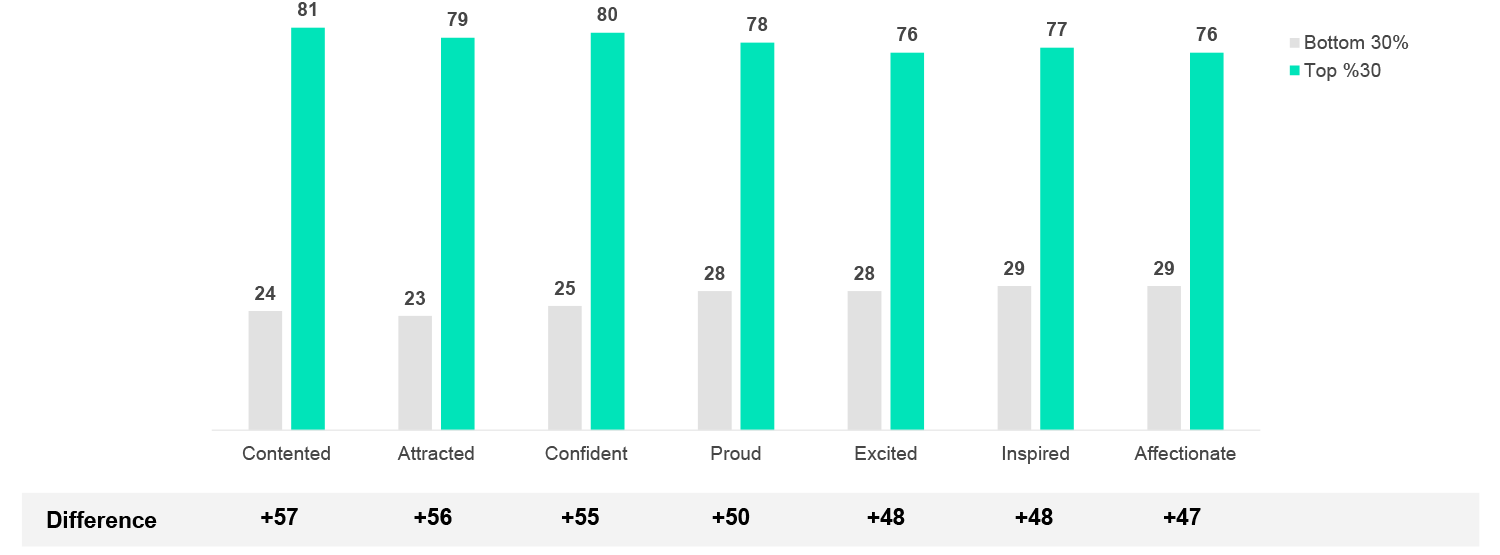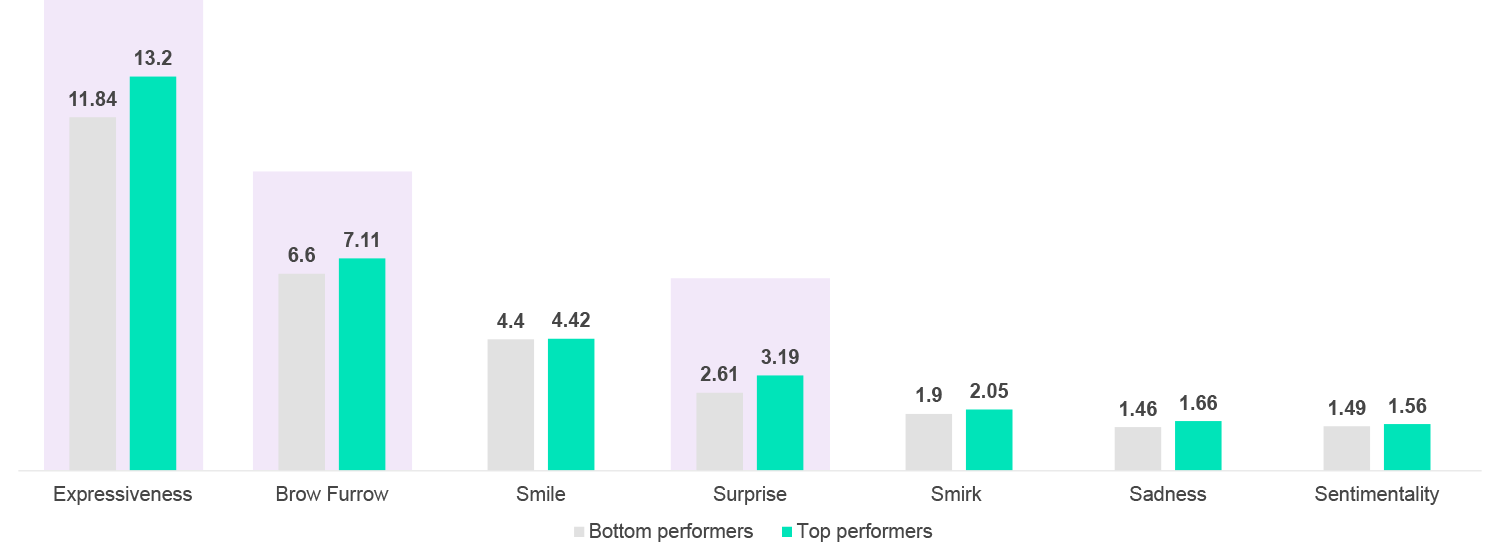As digital advertising matures, it’s time for advertisers to treat it as an important brand-building channel as well as a transactional one – and leverage emotions and human stories to deliver impact. Brands should be conscious of how they communicate via digital channels and ensure their digital presence is doing the job it's intended to and contributes to their meaningfully different position.
The online world is rapidly growing and is an undeniable part of everyday life. We are online both in our professional and social lives, and this has significantly increased post-pandemic. The evolution we observe in the online world is also reflected in how digital advertising has evolved since pop-ups and challenges with targeting. Consequently, we see a change in the way people perceive digital advertising. According to Kantar’s Media Reactions study, people are becoming more receptive to digital advertising. Digital channels increased most in positivity in 2022 compared to 2021, with online video at the forefront. Not surprisingly, marketers are also planning to spend more on digital channels.
Given the ever-present progression of the digital world, brands should be conscious of how they communicate via digital channels and ensure their digital presence is doing the job it's intended to and contributes to their meaningfully different position. So how can you ensure your digital campaigns are effective and ultimately contribute to brand equity?
Beyond the click
Behavioural metrics such as clickthrough and completion rates are often used as a barometer for a digital campaign’s success. Our analysis, however, shows that behavioural metrics don’t predict campaign success or brand impact. We must go deeper to understand how digital ads work to increase the chances of them achieving their objectives. Understanding how behaviour and attitudes work together is key.
Understanding emotion in a digital world
Looking at ads in our Link pre-testing database where we also know the sales outcomes of campaigns, it’s clear that measures of simple attention show some relationship with sales: but measures such as facial expressiveness, which indicate a degree of emotional or cognitive engagement with the content, are far better predictors. And this is enhanced further if we look at attitudinal responses. In other words, we need to take both emotional engagement and attitudinal responses to an ad into account to provide the best understanding.
At Kantar, we use Affectiva’s emotion AI facial coding technology in ad testing to understand emotional responses to advertising. To explore the power of emotion in digital advertising we conducted a meta-analysis using Kantar and Affectiva databases to discover how digital campaigns work. We took all digital ads and split them into top and bottom performers to investigate how they differ. Top performers were classed as scoring in the top 30% of the Link database on their likelihood to contribute to brand equity in the long term, and bottom performers were those ads scoring in the bottom 30% of the database on that measure. We also tested some new ads to further examine different emotional responses.
We identified 5 key takeaways from our analysis that help to drive powerful digital campaigns that harness the power of emotion and ultimately contribute to brand equity.
1. Emotional positivity drives brand impact
Emotional connections are what give brands meaning. A brand should meet not only functional but also emotional needs in relevant ways to generate meaningful associations in consumers’ minds. And every digital ad is an opportunity to reinforce that.
Our analysis shows that digital ads that leave consumers with strong emotions are four times more likely to drive long-term brand equity and four times more likely to generate impact compared to those with weaker emotional connections. They are also more likely to go viral.
Digging deeper to discover which emotions specifically contribute to digital advertising’s success, we found that the key is to leave consumers with positive emotions: Top-performing digital ads are far more likely to leave people feeling good across the board – including positive feelings such as contented, attracted, and confident.
Ads with strong emotion leave viewers with positive feelings
 Source: Kantar Link database
Source: Kantar Link database
2. Intrigue early to mitigate skipping
You don’t have much time to build engagement in online advertising. The nature of digital channels doesn’t allow you to solely rely on a big story reveal at the end of the ad. You need to intrigue viewers early on and give a compelling reason for them to continue watching. Your ad might have the greatest story resolution ever, but if viewers cannot find a reason to keep watching no one will see that story unfolding at the end.
This is where the role of emotion becomes even more crucial in digital advertising. We found that people who skipped early didn’t engage with the content from the beginning, but those that did engage tended to stay with the ad. So, the action is clear, you need to build intrigue already through the initial moments - which could be through triggering a variety of emotions as long as the story resolves positively.
3. Create a dynamic emotional story
While it is important to close with positivity, don’t be afraid to build a narrative that elicits different emotions throughout to retain attention.
We saw that top-performing digital ads are more likely to generate any emotional response, as shown by overall expressiveness. But specifically, they are more likely to generate brow furrows and expressions of surprise. This might seem counterintuitive, but when we think about the importance of building intrigue early in digital ads and the number of successful digital ads that have twists and turns, it’s not such a surprise.
Strong digital ads that build brand equity trigger more emotional experiences

Source: Kantar Link database
Lea Campos, from Kotex, is a great example of this. The ad, launched in Brazil, is 3 minutes long. A digital ad of this length has both potential advantages and disadvantages. It can use the advantage of its length to leverage the power of storytelling and take consumers on a dynamic emotional journey, but also it is harder to retain the attention and avoid skipping with a longer ad. Lea Campos manages to pull it off. The ad tackles sexism through the story of Lea Campos, the first female football referee, and the challenges she faced simply because of her gender.
Kotex, Lea Campos

As the story progresses, viewers experience a range of emotions - not limited to positive ones, which is not surprising considering the unpleasant experiences Lea went through. But as previously mentioned, in the end, the ad conveys an empowering message and leaves viewers inspired and hopeful.
Kotex, Lea Campos: taking people on an emotional journey

Source: Affectiva facial coding
4. Connect with consumers through humour
While it is clear that when it comes to successful digital advertising, emotions, and especially leaving people in a positive place, are important, there is also evidence that overall, digital advertising may not be exploiting positive emotions effectively. Based on analysis from the Affectiva database comparing the average levels of different expressions evoked by digital video ads compared to the norms for all media, digital ads in general tend to under-index on emotional engagement as measured by expressiveness, particularly on the levels of smiles evoked.
What might the digital advertising overall be missing that makes it fall behind in emotional engagement, especially smiles?
If you think about what makes people smile, of course, humour is the first thing that comes to mind. Humour is not only a great vehicle to engage viewers positively, but it also offers a great opportunity to humanise your brand and build affinity through emotion. Especially in the context of digital, according to Kantar’s Ad Reaction study humour is the main way to prevent skipping ads. What we also see from our Link database that while humour has not been used effectively across channels, it is more pronounced in digital advertising. Moreover, though it’s mounted a comeback in TV advertising last year, there is little sign of that trend being mirrored in digital advertising. So digital ads should use humour more.
5. Get the basics right
While digital advertising has its own unique challenges, such as the need to tailor content to the context or prevent skipping, the very basic principles of effective creative still apply: Drive branded engagement, imprint meaningfully different associations, and create short and long-term predisposition.
There is no point getting emotion right without other creative success factors. Even ads that generate great emotional engagement will not succeed if the brand is not clear, or the message is not motivating.
To learn more about our research watch our on-demand webinar where we uncover how top-performing digital ads harness the power of emotion and positivity, and show examples of these in action. And of course, please get in touch to discuss our findings further.

